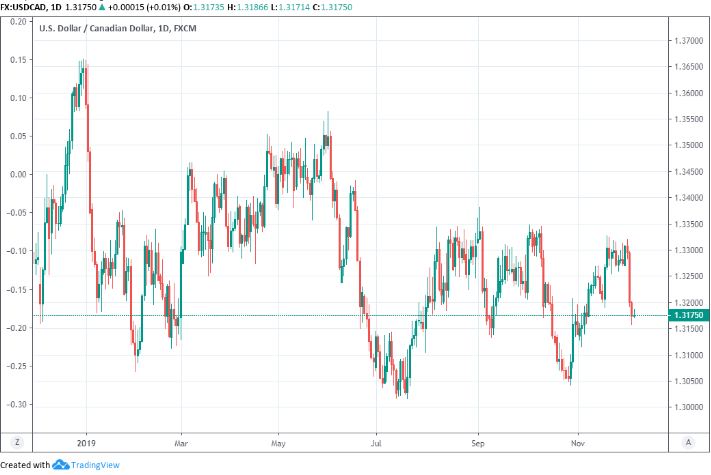Canadian Dollar Pinned against Ropes after Trade Data, ahead of OPEC Statement
- Written by: James Skinner
-

Image © Pavel Ignatov, Adobe Stock
- CAD pinned against ropes after trade data, ahead of OPEC, BoC.
- Deficit number obscures positive trade developments in October.
- No respite for the CAD ahead of Poloz speech and OPEC decision.
The Canadian Dollar remained on its back foot Thursday after official data revealed a wider trade deficit for October and as markets await a crunch decision about production cuts by the Organization of Petroleum Exporting Countries (OPEC), both of which are key to the outlook for the Loonie.
Canada's goods trade deficit widened to -$1.2 billion in October, from an upwardly-revised -$891 million in September, when markets had looked for a deficit of just -$700 million. September's deficit was previously reported as -$400 million.
The deficit widened after exports fell -1.2% and imports declined by only -0.6%, which much of the decline in export values the result of the oil market having effectively gone bust during the month.
"Exports of energy products fell 12.4% to $8.8 billion in October. Exports of crude oil (-16.2%) drove the decrease, offsetting most of the earlier gains in 2018. Crude oil export prices were down 15.4%, the strongest monthly decrease since February 2016," Statistics Canada says.
The bottom fell out of the oil market during October, with the global benchmark Brent crude declining by 10% in that month alone while Western Canadian Select plumbed fresh record lows. Prices continued falling through November so data for that month could follow a similar pattern when it is released in January.
However, the trade report wasn't all bad news for the Canadian economy or Dollar because after adjusting for the impact of changes in prices, exports actually rose during the month.
"The 1.2% decline in nominal exports was driven by lower prices, particularly for energy products, and in volume terms exports were actually up a little over 1%," says Andrew Grantham, an economist at CIBC Capital Markets. "So despite the downside miss on the headline, this is a solid first indicator for manufacturing shipments and monthly GDP."
Trade balance data measures the difference between a nation's imports and its exports. Currency markets care about it because the data provides insight into real world supply and demand of a currency, while also giving a steer on the likely pace of GDP growth in a given period.
A narrowing deficit suggests either that exports and their associated demand for a currency are rising, or that imports and their associated supply of a currency on global markets are falling. Both are typically positive while a steadily narrowing trade surplus, or a widening deficit, is a negative influence.
The size and trajectory of a trade surplus or deficit is important for economic growth because imports are a subtraction in the calculation of GDP, while exports represent a credit to the value of output. Rising export volumes and, or, falling imports can help boost the economy.

Above: USD/CAD rate shown at daily intervals.
The USD/CAD rate was quoted 0.37% higher at 1.3412 following the report, after rising more than 1% Wednesday, and is now up by 6.7% for 2018.
The Pound-to-Canadian-Dollar rate was 0.67% higher at 1.7034 after climbing 1% Wednesday and is now up 1.06% for the year overall.
Both exchange rate moves denote a stronger U.S. Dollar and Pound Sterling as well as a weaker Canadian Dollar.
Above: Pound-to-Canadian-Dollar rate shown at daily intervals.
Thursday's data comes after an eagerly-anticipated speech from Bank of Canada (BoC) governor Stephen Poloz, and in the wake of the bank's December interest rate statement, which saw policymakers back away from earlier guidance that they would step up the pace at which they raise interest rates in 2019.
"The Bank of Canada was forced to pivot away from it's hawkish commentary in yesterday's rate announcement, and Governor Poloz reinforced that revised message today. Poloz acknowledged that data since the last MPR has been disappointing, with news out of the oil patch dominating the Governing Council's discussions ahead of the interest rate decision," says Royce Mendes, an economist at CIBC.
That dealt a severe blow to the Canadian Dollar on Wednesday, although a disappointing trade number could further hurt the Loonie as it would merely add to concerns about the outlook for BoC policy.
Canada's trade balance data hit the wires as markets await the outcome of the OPEC meeting and as pressure from the White House, to avoid a price-boosting production cut, grows.
Most analysts anticipate some kind of a cut to production, although there is uncertainty whether it will be enough to sustainably lift oil prices.
Hopefully OPEC will be keeping oil flows as is, not restricted. The World does not want to see, or need, higher oil prices!
— Donald J. Trump (@realDonaldTrump) December 5, 2018
"Our view is that a cut of modestly over one million b/d is likely to materialize," says Bart Malek, head of commodity strategy at TD Securities. "It should be noted that while cuts of this magnitude would send prices materially higher, they are unlikely to send them past $80 Brent and $70 WTI, which should not upset the White House too much."
Trump has frequently hit out at Saudi Arabia and the Organization of Petroleum Exporting Countries over their efforts to manipulate oil prices in favour of producer nations, despite the U.S. being an oil producer itself.
Rising oil prices benefit producer nations by driving up export revenues and supporting economic growth, among other things. If OPEC cuts production significantly Thursday, it could help lift the price of Canadian oil, which might then lead to an easing of pressure on the Loonie.
But rising prices are a headwind for everybody else other than producer nations because they lift inflation, which reduces growth if there is not a concurrent pickup in activity within an economy.
For the White House, the issue with higher prices could be that they add to inflation, which merely encourages the Federal Reserve to go on raising its interest rate. Trump has frequently criticised the Fed and its monetary policy for placing U.S. economic growth, which has been buoyed by tax cuts, in jeopardy.
"OPEC is launching trial balloons ahead of its December 6th general meeting. According to our models, the advisory committee's telegraphed 1.3 million b/d cut would imply a modest deficit. For now, the market is unsure if Russia and others are ready to participate in the cuts," TD's Malek says.
Advertisement
Bank-beating exchange rates. Get up to 5% more foreign exchange by using a specialist provider to get closer to the real market rate and avoid the gaping spreads charged by your bank when providing currency. Learn more here
